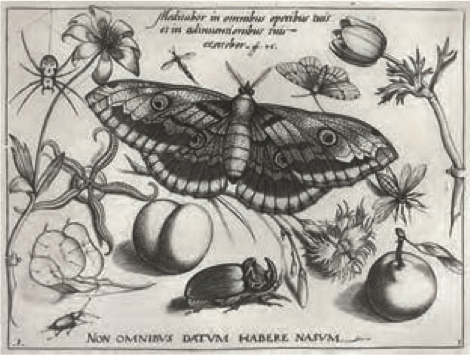Pieter Holsteijn the Younger
(Haarlem 1614 - 1673 Amsterdam)
Viennese emperor moth
Pen and ink and watercolour with body colour, 162 x 211 mm
Paper, three edges trimmed smoothly, right edge ragged, watermark (lower edge, cropped): coat of arms (shield per bend sinister; watermark D)
Inscribed PH (monogrammed, on the right below the moth)
The verso bears two sketches in black chalk of a peacock butterfly, one with outspread wings, the other with folded wings (fig. 1)
Provenance:
Private collection, Switzerland.
With a wingspan of up to seventeen centimetres, the Viennese emperor – or giant peacock – moth (Saturnia pyri) is considered the largest moth in Europe. Native to southern Europe and the Middle East, it is found no further north than the area around Vienna. It had already been depicted by Joris Hoefnagel, whose son Jacob included it in Archetypa Studiaque Patris Georgii Hoefnagelii (Frankfurt, 1592, Pars III, 1; fig. 2). Joris’s image was perpetuated beyond this in the form of a copy in Diversae Insectarum Icones (Amsterdam, 1630, no. 13). Holsteijn’s version is almost identical to Hoefnagel’s. Some features, however, including the insect’s body, differ to such a large extent that Holsteijn may be said to have modelled himself on his predecessor’s work without slavishly copying it. Holsteijn depicts the insect with great refinement, but makes no attempt to increase its three-dimensionality by subtle variations in the way he applies the colour. Neither does he include a cast shadow. The image thus appears decorative and rather flat. This may indicate that it was painted from a source image and not from a mounted specimen. Further evidence in favour of this assumption comes from the fact that the insect is not reproduced precisely, either in its proportions or its details (information kindly provided by Dr. Wolfgang Nässig, Forschungsinstitut Senckenberg, Frankfurt am Main).



